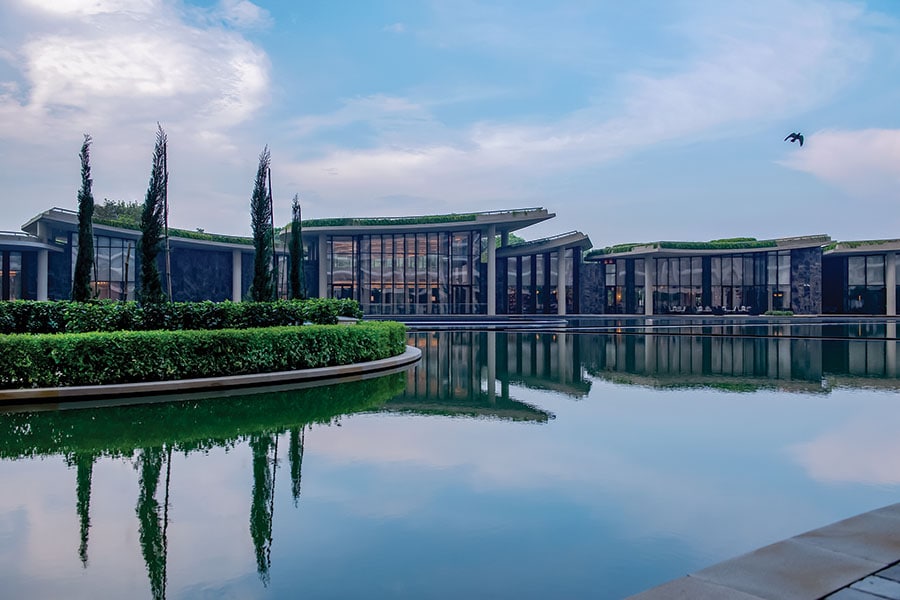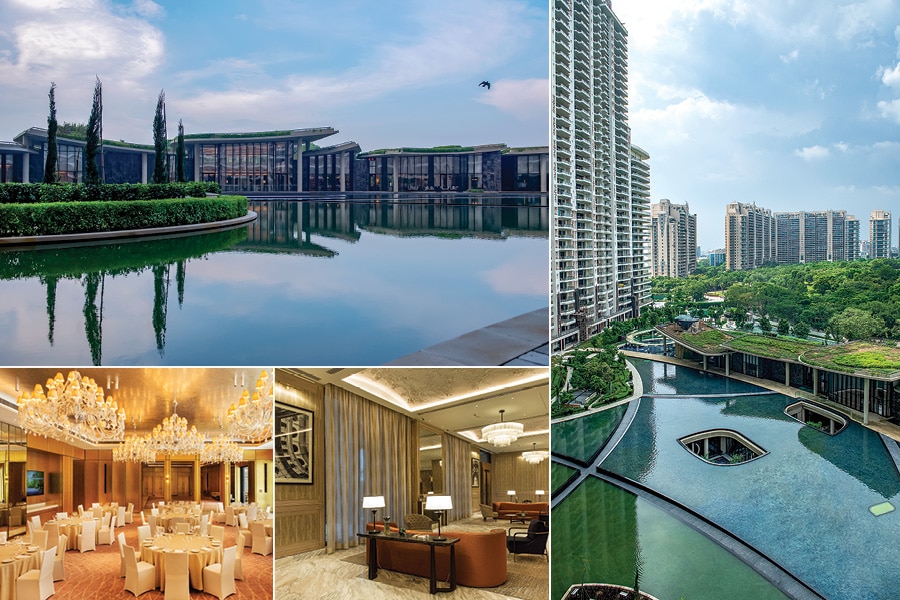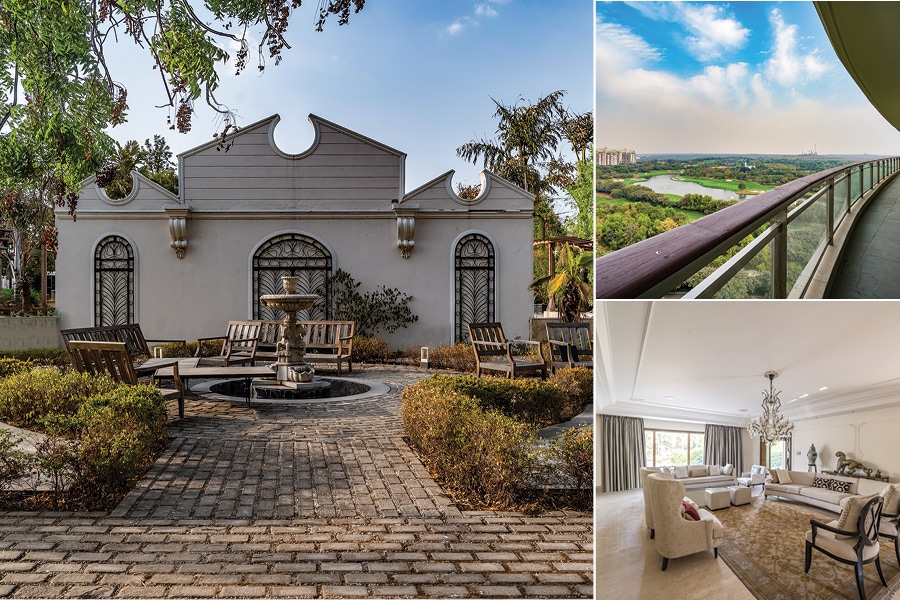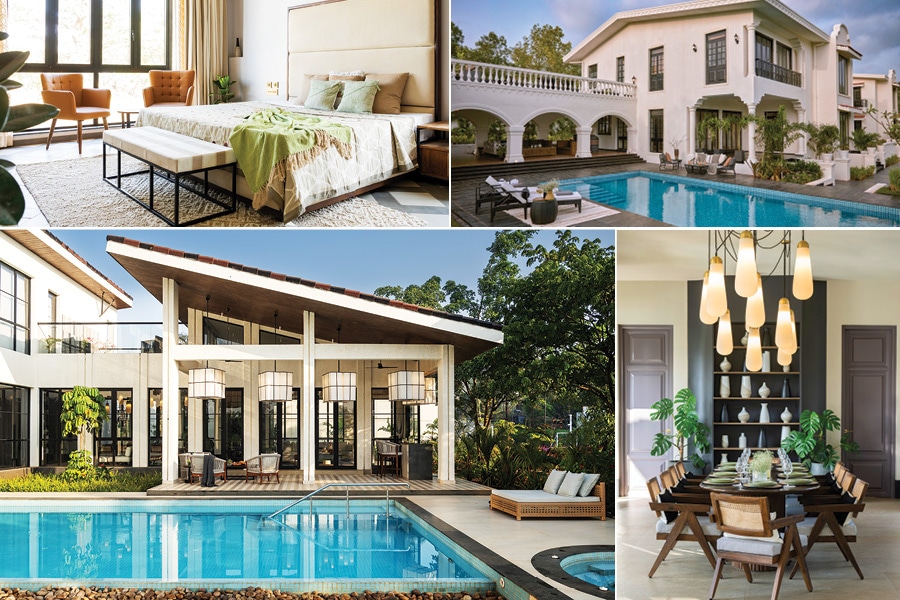
- Home
- Billionaires
- Billionaires
- Luxury real estate: What are India's rich buying?
Luxury real estate: What are India's rich buying?
As disposable incomes of HNIs and UHNIs rise, they are not just buying luxury primary homes but also secondary properties including villas, farmhouses and apartments abroad as investment options

Darielle Britto is a Special Correspondent for Forbes India, where she writes about the intriguing luxury lifestyle world and is also part of the web team. She has extensive experience in journalism focusing on long-from written features. Her work has been featured in Daily News Analysis, Hindustan Times and other prominent Indian publications. When not in search of a compelling story, she enjoys being a shutterbug.
- Heritage meets innovation in Arpita Mehta's latest bridal collection
- The Banarasi Edit by Amit Aggarwal puts the spotlight on repurposing
- Nocturnum by Rohit Gandhi + Rahul Khanna: Finding the celestial in couture
- Abhishek Agarwal: Creating wealth by offering health
- Top bridal and fashion jewellery trends dominating this season
- More people are buying ultra luxury homes in India. Here's why
- No longer a mere possession: Rich millennials are overhauling the luxury yacht industry
- Art as an investment: How to build an art collection from scratch
- Glamping the great outdoors in uber luxury
- Inside the world of bespoke private jet tours that could rewrite how the rich travel and holiday
 The resurgence in India’s luxury residential real estate has spurred robust growth [in the luxury residential real estate market.Image credit: DLF Home Developers Ltd
The resurgence in India’s luxury residential real estate has spurred robust growth [in the luxury residential real estate market.Image credit: DLF Home Developers Ltd
High-end residential properties are in great demand across India as the number of High-Net-Worth Individuals (HNI) and Ultra High-Net-Worth Individuals (UHNIs) with significant disposable income has been on the rise due to the country’s rapid economic growth.
This has led to a significant increase in a growing aspiration for a lifestyle that includes lavish living spaces with cutting-edge amenities.
Related stories
“India’s luxury real estate market is going through a substantial shift, with a projected growth rate of over 5 percent from 2023 to 2028,” says Ritesh Mehta, senior director/head-north, east & west residential services, JLL. “The resurgence in India’s luxury residential real estate has spurred robust growth [in the luxury residential real estate market] as about 45 percent of the overall luxury stock was injected in the last five years alone,” he adds.
According to Anuj Puri, chairman, Anarock Group, luxury housing had a mere 4 percent share back in Q1 2019, “indicating that trends have visibly reversed completely”.
“The segment has also grown at a CAGR of over 9 percent since 2019 across the gateway cities,” adds Mehta.
While lifestyle upgrades are a significant motivator, India Sotheby’s International Realty’s Luxury Outlook Survey 2024 reveals that most affluent investors now prioritise capital appreciation as their primary reason for buying real estate.
“This shift indicates a resurgence of investor activity in the property market,” says Ashwin Chadha, CEO, India Sotheby’s International Realty. “Additionally, many surveyed investors expressed a desire to create assets for the next generation, suggesting a long-term investment approach and desire to pick up quality luxury real estate in prime locations.”
Supply of new luxury homes, says Puri of Anarock, stood at nearly 28,020 units in the first quarter of 2024. “As things stand now, we expect at least 5-10 percent rise in the overall new supply of luxury homes in the coming quarters,” says Puri.
Latest Anarock Research also indicates that out of the approximate 1,30,170 units sold across the top seven cities in Q1 2024, the share of luxury home sales priced >Rs 1.5 crore stood at 21 percent comprising sale of approx. 27,070 units, he adds.
The luxury housing segment has emerged as a highly attractive investment option, particularly among UHNIs, HNIs, NRIs, and industrialists. “Non-Resident Indians (NRIs) are increasingly investing in India’s luxury real estate market, injecting $13.1 billion into the sector in 2023 alone,” says Mehta, adding, “It is projected that NRIs will contribute to 25 percent of the country’s total real estate investments by 2025.”
Discounts and multiple offers by developers initially during the pandemic made such properties even more lucrative and attractive for several buyers. “In this backdrop (amid rising consumer demand), developers changed their strategy [from affordable housing] and came forward to launch more projects in the luxury category, thereby increasing the new supply,” says Puri.
So, what are Indians buying in luxury real estate?
Also read: What's led to the revival of India's luxury real estate?
High-end apartments and condominiums
There is a strong demand for high-end condominiums and modern apartments with spacious layouts and a multitude of amenities.
“Buyers are increasingly seeking homes that offer not only luxury and comfort but also modern conveniences such as fitness centres, spas, concierge services, and advanced security systems,” says Chadha.
The disruption caused by the pandemic has played a role in the increased popularity of branded residences, penthouses, sky villas, and independent floors within well-equipped townships, according to Mehta.
“In the luxury segment, which includes apartments priced at Rs 3 crore and above, the share of quarterly sales has seen a remarkable surge,” says Mehta. Adding, “It has grown from 5 percent in Q1 2022 to 11 percent in Q1 2024.”
Mumbai accounts for nearly half of the country’s total luxury inventory. “Locations such as Altamount Road, Nepean Sea Road, Worli, Prabhadevi, Juhu, and Bandra (West) in Mumbai command high capital values owing to premium locations, with an average ticket size ranging from Rs 20 crore to over Rs 60 crore,” says Mehta. “Occasionally, apartments priced above Rs 100 crore make headlines.”
Hyderabad is emerging as a hotspot with 10 percent share of the country’s luxury inventory, which has been driven by a pro-business environment.
“The city has witnessed an influx of luxury apartments and a surge in demand within this segment,” says Mehta. “Areas such as Jubilee Hills, Banjara Hills, Hitech City, Raidurg and Neopolis report sales ranging from Rs 20 crore to over Rs 40 crore.”
 Golf course properties offer a unique lifestyle centred around the sport of golf attracting affluent buyers who value exclusivity and premium amenities.Image credit: DLF Home Developers Ltd
Golf course properties offer a unique lifestyle centred around the sport of golf attracting affluent buyers who value exclusivity and premium amenities.Image credit: DLF Home Developers Ltd
Golf course properties
Golf course properties have become highly sought-after, with projects like The Camellias in DLF Gurgaon and Prestige Golfshire in Bengaluru dominating the market.
“These properties offer not only luxury living but also a unique lifestyle centred around the sport of golf, high-end and spacious club houses, attracting affluent buyers who value exclusivity and premium amenities,” says Chadha.
Aakash Ohri, joint MD and CBO, DLF Home Developers Ltd, reveals that while nearly 85 percent of the people who have invested in The Camellias are from India, the development has also attracted NRIs from across the USA, UK, Middle East and South-East Asia.
Gurugram’s DLF5 Golf Links residences, including The Aralias, The Magnolias, and The Camellias are among the most coveted addresses in the country. They are also known for their high rental yields and capital appreciation.
According to DLF, since the pandemic, The Aralias’ prices have surged from Rs 12-12.5 crore to Rs 30+ crore, and The Magnolias’ prices have risen from Rs 16-16.5 crore to Rs 40 crore.
There is also strong demand in both re-trade and rental markets for the exclusivity of DLF’s super luxury properties.
According to DLF, rental rates at The Camellias start from Rs 10.5 lakh for an unfurnished apartment and Rs 15 lakh per month for a furnished one. Pre-pandemic, The Aralias had rental rates starting at Rs 2.6 lakh to 2.7 lakh for a 5,800 square foot unit, increasing to Rs 4.5 lakh to 4.75 lakh for a fitted apartment and Rs 5.5 lakh to 6 lakh for a furnished one. Similarly, The Magnolias saw rents rise from Rs 3.7 lakh to Rs 3.8 lakh per month to Rs 5.5-6 lakh for a fitted apartment and Rs 6.5-7 lakh for a furnished one.
The next super luxury project by DLF Home Developers Ltd, in DLF5 Gurugram, is set to be launched, possibly, by the end of FY25 and the price points are expected to be reasonably higher, upwards of `50 crore.
 There has also been a growing desire for farmhouses in suburban areas and city peripheries.Image credit: India Sotheby’s International Realty
There has also been a growing desire for farmhouses in suburban areas and city peripheries.Image credit: India Sotheby’s International Realty
Holiday homes, farmhouses and villas
The demand for luxury housing is robust across various segments, not just primary homes. Responses to India Sotheby’s International Realty (ISIR) 2024 survey reveal a diverse real estate portfolio, with 25 percent holiday homes and 20 percent farmhouses.
“A need for more spacious homes in scenic locales, ability to work remotely, capital appreciation, professionally managed properties and ability to lease and maintain it and investment for future retirement are the factors influencing the decision to invest in holiday homes, villas and farmhouses,” says Reshmi Panicker, executive director-land services and residential, Knight Frank India.
Most clients of Isprava Group, which focuses on non-urban luxury real estate, have purchased homes in Goa, followed by Alibaug.
“The overall industry typically operates at an average deal value of around $0.4-0.5 million (Rs 3.3 crore to Rs 4.1 crore). At Isprava, our average deal value is in the range of $1.5 million (approximately Rs 12 crore),” says Nibhrant Shah, 39, co-CEO & managing director, Isprava Group.
Isprava offers three distinct types of luxury homes: Estates, villas, and vaddos. They are designed to capture the essence of location-centric architecture with a seamless integration of indoor and outdoor living spaces, and provide an opulent community living experience with high-end amenities.
“Each home we build is unique, as we meticulously interpret our clients’ specific requirements through their preferences and deliver accordingly, epitomising true luxury,” says Shah.
 Many clients of Isprava Group have purchased luxury homes in Goa and Alibaug.Image credit: Isprava Group
Many clients of Isprava Group have purchased luxury homes in Goa and Alibaug.Image credit: Isprava Group
Some of Isprava’s builds include a treehouse for the owner’s children in a Goa property, a yoga deck and barbecue zone in a Coonoor residence, and features like a pickleball court, state-of-the-art gym, co-working space, and electric scooters in one of their high-end communities.
Increased tourism and foreign investment in the real estate market in Goa has made it a lucrative investment opportunity. DLF will enter Goa for the first time with a first-of-its-kind project in the city: Uber luxury residential villa community. “These villas will attract high-end buyers and the strategic location offers easy connectivity to North Goa and major highways, enhancing the appeal for investors and residents alike,” says Ohri.
While Goa remains the number one pick for holiday luxury homes, Chadha reveals other destinations in demand are beach and hill locations easily accessible from mega metros—Alibaug and Lonavala near Mumbai, Rishikesh, Dehradun, Kasauli near Delhi and Coorg, near Bengaluru.
“We have grown significantly, demonstrating a CAGR of over 30 percent per year over the last four years,” says Dhimaan Shah, 37, co-CEO & executive director, Isprava Group. “This trajectory reflects our continuous expansion and increasing market presence in key regions like Goa, Alibaug, Karjat, and Kasauli.”
“Karjat, with its lush landscapes and proximity to Mumbai, and Kasauli, known for its serene hills and cool climate, are set to become prime destinations for luxury second homes,” adds Dhimaan Shah.
There has also been a growing desire for farmhouses in suburban areas and city peripheries. A need for larger living spaces, open green areas, and the flexibility to work from home, along with exclusive amenities like private swimming pools are some of the driving factors.
“Additionally, farmhouses in Delhi and villa projects by reputed developers located within a drivable distance from business districts in top cities continue to be in high demand,” says Chadha.
Also read: Rizwan Sajan's journey: From the slums of Ghatkopar to the glitzy world of luxury in Dubai
Interest overseas
On the international front, the desire to invest in overseas property has remained relatively stable, according to India Sotheby’s International Realty’s Luxury Outlook Survey 2024. “This year, 12 percent of high-net-worth individuals (HNIs) expressed their intention to buy real estate abroad, compared to 11 percent in the 2023 survey,” says Chadha.
Twenty-one percent of Indian Ultra High Net-worth Individuals (UHNIs), Mehta reveals, showed an affinity towards purchasing homes outside India. “When compared to investments in Indian markets, the yields for both capital and rental are higher in some foreign locations,” he says.
In most cases, Chadha says Indian buyers prefer city apartments abroad as they are convenient to manage and offer better returns in terms of rental income and appreciation.
“We recently facilitated the sale of a penthouse in Mayfair, London for about $5.35 million (approx. Rs 44 crore),” Chadha reveals. “This lateral four-bedroom apartment, spread over 2226 sq ft, in the heart of Mayfair is set on the seventh floor of a striking art deco building.”
The UAE, the UK, the US, Canada, Singapore, Portugal, Cyprus are some of the favoured destinations for Indians to invest in a property abroad.
“These are favoured for various reasons–golden visa, tax benefits, relaxed visa norms, employment opportunities, medical and health benefits offered, quality of life, environment, economic stability, high standard of living, safety and presence of family / Indian communities,” reveals Panicker. “Based on the affordability, Indian buyers are typically purchasing apartments but the ultra HNIs are opting for villas and countryside estates.”
Many countries offer citizenship or allow a longer stay to immigrants who invest or buy properties. “The EB 5 US Immigrant Investor Visa Program is available to Indian citizens,” says Mehta. “Likewise, Canada, Portugal, Cyprus offer various schemes to attract immigrants.”
Chadha adds: “Dubai’s ‘Golden Visa’ programme, which allows non-residents to live in the country for up to 10 years in exchange for making investments, is particularly popular among Indians.”
Also read: Ultra-luxury real estate: Selling homes that last generations
Set to grow
India, according to Ravi Shankar Singh, managing director, residential transaction services, Colliers India, is pegged to become a developed economy by 2047.
A focus on infrastructure development to boost trade, alongside a stable government, a young population, and high domestic consumption is attracting significant foreign capital.
“All these factors would lead to higher disposable incomes and further create demand for quality real estate across the country,” says Singh.
Panicker believes the luxury real estate market is here to stay and will continue to evolve with newer offerings. “With the growth of infrastructure in the country, more and more people are finding luxury options matching their requirements outside city limits and I believe this trend would continue in the coming years,” he says.

















